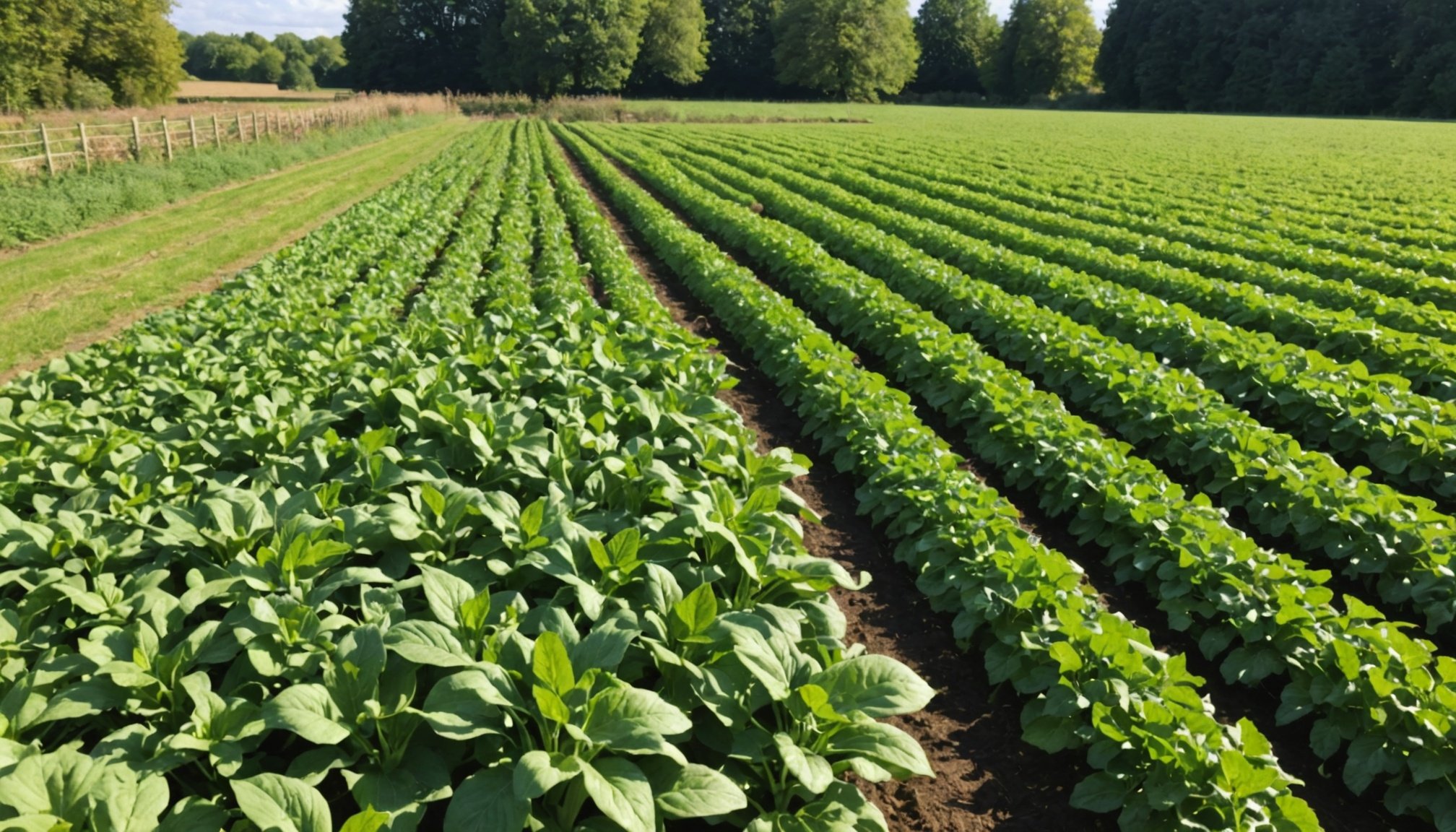Unlocking the Secrets: Effective Strategies to Enhance Crop Rotation Advantages in Your UK Garden
Understanding the Basics of Crop Rotation
Crop rotation is a fundamental practice in sustainable agriculture that has been used for centuries to maintain soil health, improve crop yields, and reduce the need for synthetic fertilizers and pesticides. In the context of your UK garden, implementing effective crop rotation strategies can be a game-changer for both novice and experienced gardeners.
Why Crop Rotation Matters
Crop rotation is more than just switching between different crops; it’s a holistic approach to farming that addresses several critical aspects of agricultural health. Here are some key reasons why crop rotation is essential:
Avez-vous vu cela : Maximizing Vertical Spaces: Top Strategies for Urban Gardening Success in the UK
- Soil Health: Different crops have varying nutrient requirements and can either deplete or enrich the soil. For example, legumes like peas and beans are nitrogen-fixers, which means they convert atmospheric nitrogen into a form that is usable by plants, thereby improving soil fertility[3].
- Nutrient Cycling: Crop rotation helps in cycling nutrients through the soil, reducing the need for external fertilizers. This natural process enhances soil structure and fertility, making it more conducive for plant growth.
- Pest and Disease Management: Rotating crops disrupts the life cycles of pests and diseases, reducing the risk of infestations and infections. This approach is particularly beneficial in organic farming practices where chemical pesticides are avoided.
- Biodiversity: Crop rotation promotes biodiversity by introducing a variety of plants into your garden, which in turn supports a broader range of beneficial insects and microorganisms.
Planning Your Crop Rotation
To maximize the benefits of crop rotation, you need to plan carefully. Here are some steps and strategies to help you get started:
Choose the Right Crops
Selecting the right crops for your rotation is crucial. Here are some categories of crops that work well together:
A lire aussi : Discover the Best Companion Plants for Growing Apple Trees in South-East UK!
- Nitrogen-Fixers: Legumes such as peas, beans, and clover are excellent for improving soil nitrogen levels.
- Brassicas: Broccoli, cauliflower, and cabbage are good for following legumes as they benefit from the increased nitrogen.
- Root Vegetables: Carrots, potatoes, and beets can follow brassicas, helping to break up compacted soil.
- Cover Crops: Planting cover crops like rye or oats during off-seasons helps in enhancing soil health and preventing soil erosion.
Example Crop Rotation Plan
Here’s a simple example of a crop rotation plan for a small UK garden:
| Season | Bed 1 | Bed 2 | Bed 3 |
|---|---|---|---|
| Spring | Peas (Legumes) | Broccoli (Brassicas) | Carrots (Root Vegetables) |
| Summer | Beans (Legumes) | Cabbage (Brassicas) | Potatoes (Root Vegetables) |
| Autumn | Clover (Legumes) | Kale (Brassicas) | Beets (Root Vegetables) |
| Winter | Rye (Cover Crops) | Oats (Cover Crops) | Wheat (Cover Crops) |
Incorporating Cover Crops
Cover crops are an integral part of any crop rotation strategy. They serve multiple purposes:
- Soil Erosion Prevention: Cover crops help hold the soil in place, preventing erosion during periods of heavy rainfall or strong winds.
- Soil Health Improvement: They add organic matter to the soil, improve soil structure, and support beneficial microorganisms.
- Weed Suppression: Cover crops can outcompete weeds, reducing the need for herbicides.
Enhancing Soil Health Through Crop Rotation
Soil health is the backbone of any successful garden, and crop rotation plays a vital role in maintaining it.
Organic Matter and Soil Structure
Crop rotation helps in adding organic matter to the soil, which is crucial for improving soil structure. Here’s how different crops contribute:
- Legumes: Add nitrogen and organic matter.
- Brassicas: Help in breaking up compacted soil.
- Root Vegetables: Aerate the soil and improve drainage.
- Cover Crops: Add bulk organic matter and improve soil porosity.
Nutrient Management
Effective nutrient management is key to sustainable agriculture. Here are some tips on how crop rotation can help:
- Avoid Monoculture: Monoculture depletes the soil of specific nutrients. Rotating crops ensures a balanced nutrient profile.
- Use Green Manure: Incorporate green manure (cover crops) into your soil to add nutrients naturally.
- Minimize Synthetic Fertilizers: By using natural nutrient cycling, you reduce the need for synthetic fertilizers, making your farming practices more sustainable.
Managing Water and Climate in Crop Rotation
Water management and climate resilience are critical components of any agricultural system.
Water Conservation
Crop rotation can help in water conservation in several ways:
- Drought-Tolerant Crops: Incorporate drought-tolerant crops into your rotation to reduce water dependency.
- Soil Moisture Retention: Certain cover crops help in retaining soil moisture, reducing the need for frequent watering.
- Mulching: Mulching around plants helps in retaining soil moisture and reducing evaporation.
Climate Change Mitigation
Crop rotation can also play a role in mitigating the effects of climate change:
- Regenerative Agriculture: Practices like regenerative agriculture, which include crop rotation, help in sequestering carbon in the soil, thereby reducing greenhouse gas emissions[5].
- Climate-Resilient Crops: Choose crops that are resilient to changing climate conditions, such as more frequent droughts or floods.
Practical Insights and Actionable Advice
Here are some practical tips and advice to help you implement effective crop rotation strategies in your UK garden:
Start Small
- Begin with a small plot and gradually expand as you gain experience.
- Keep a garden journal to track your crop rotations and note any observations.
Monitor Soil Health
- Regularly test your soil to understand its nutrient profile and pH levels.
- Add organic matter like compost or manure to improve soil fertility.
Diversify Your Crops
- Include a variety of crops in your rotation to promote biodiversity.
- Experiment with different cover crops to find what works best for your garden.
Engage with Your Community
- Join local gardening groups or online forums to share knowledge and learn from other gardeners.
- Participate in workshops or webinars on sustainable farming practices.
Crop rotation is not just a technique; it’s a philosophy that underpins sustainable agriculture. By understanding the basics, planning carefully, enhancing soil health, managing water and climate, and following practical insights, you can unlock the full potential of your UK garden.
As Dr. Charles Benbrook, a renowned expert in sustainable agriculture, once said, “Crop rotation is one of the most powerful tools available to farmers for improving soil health, reducing pest and disease pressure, and enhancing biodiversity.”
By adopting these strategies, you are not only improving your garden’s productivity but also contributing to a more sustainable and regenerative agricultural system that benefits both your local community and the environment at large. So, start planning your crop rotation today and watch your garden thrive in the long term.






